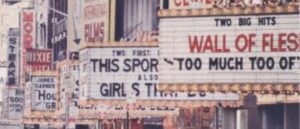There are just too damn many movies. And not nearly enough good ones.
By my count, the New York Times ran reviews of 19 different movies on Friday, March 8. On March 15, they ran reviews of 18 more. This Friday, there are more than a dozen more scheduled to open in New York.
Every day, it seems, I get a half-dozen invitations to screenings – or, as is more often the case lately, an offer to send me a DVD screener or a link to stream the movie online.
But until I learn to DVR my life – to be able to put live-action on pause while I do something else, until I can come back to it, without actually losing the time it takes to do it – it’s both a physical and a temporal impossibility to see them all, or to even see the majority of them.
And here’s the most important thing: The majority of them aren’t worth seeing or reviewing.
There used to be filters for this kind of thing. They were called film festivals. When I go to Sundance and Toronto, the figures seem to expand each year: 2,000 films, 3,000 films, even 4,000 films submitted for entry, of which a couple hundred titles are selected to be shown. Out of those, a small (but obviously growing) percentage would actually be released.
I used to wonder: What happens to all the films that don’t get into the festivals? And all the ones that get into the festivals but never make it to theaters? The answer used to be: nothing. That was it. Those filmmakers chalked the movie up to experience, apologized to their investors (or paid them back) and moved on with their lives.
It was big news in 1987 when actor-director Robert Townsend made “Hollywood Shuffle,” by accepting all the credit-card applications he received and then maxing them out to cover the cost of making his own movie. Now that’s old hat, in this era of crowd-funding and other fund-raising schemes.
Meanwhile, it feels like the advent of video-on-demand has opened the floodgates. Movies don’t need actual physical prints (or even DVDs) to be shown anymore. Nor do they need theaters. They just go out on cable or satellite, on expanding networks of bandwidth that deal solely in this kind of product.
Some of that, of course, is by design. IFC, Tribeca Films and the like have created their own model of releasing their films in theaters on the same day that they’re available on DVD and on-demand. But they’re no longer alone, not by a long shot.
Now THAT market is being flooded. Because digital projection has eliminated the cost of a 35mm print, more and more movies are getting brief theatrical releases in New York, at theaters like the Quad and Cinema Village, sometimes after they’ve made their on-demand debut. The distributors’ hope is that, one way or another, these films will attract enough critical attention (and positive reviews) to set themselves apart from all the OTHER movies available on-demand.
But here’s the thing: There’s a reason these movies don’t get chosen for festivals or picked up by the larger independent companies for release. Most of them aren’t good enough.
This commentary continues on my website.

